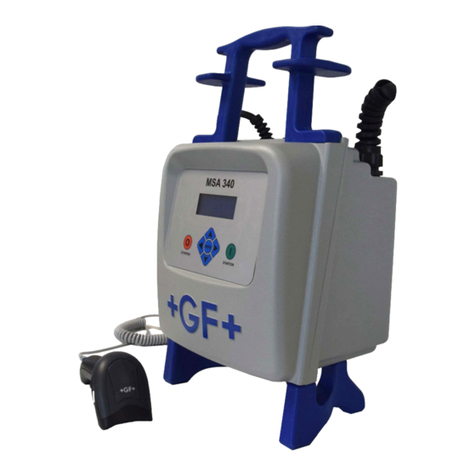
SUMMIT BRAND TECH : 330.294.9747WWW.SUMMITRACING.COM
WARNINGS CONTINUED
WARNING! Do not weld or cut around Chlorinated
solvents or degreasing areas. Release of Phosgene
gas can be deadly. Consider all chemicals to have
potential deadly results if welded on or near metal
containing residual amounts of chemicals.
WARNING! Keep all cylinders upright and chained
to a wall or appropriate holding pen. All cylinders
have a potential explosion hazard. When not in use,
keep capped and closed. Store chained so that
overturn is not likely. Transporting cylinders
incorrectly can lead to an explosion. Do not attempt
to adapt regulators to t cylinders. Do not use faulty
regulators. Do not allow cylinders to come into
contact with work piece or work. Do not weld or
strike arcs on cylinders. Keep cylinders away from
direct heat, ame and sparks.
WARNING! Electrical shock can kill. Make sure all
electrical equipment is properly grounded. Do not
use frayed, cut or otherwise damaged cables and
leads. Do not stand, lean or rest on ground clamp.
Do not stand in water or damp areas while welding
or cutting. Keep work surface dry. Do not use welder
or plasma cutter in the rain or in extremely humid
conditions. Use dry rubber soled shoes and dry
gloves when welding or cutting to insulate against
electrical shock. Turn machine on or off only with
gloved hand. Keep all parts of the body insulated
from work, and work tables. Keep away from direct
contact with skin against work.
WARNING! All work cables, leads, and hoses pose
trip hazards. Be aware of their location and make
sure all personnel in area are advised of their
location. Taping or securing cables with appropriate
restraints can help reduce trips and falls.
WARNING! Fire and explosions are real risks while
welding or cutting. Always keep re extinguishers
close by and additionally a water hose or bucket of
sand. It is a good idea to have someone help watch
for possible res while you are welding. Sparks and
hot metal may travel a long distance. They may go
into cracks in walls and oors and start a re that
would not be immediately visible.
WARNING! Metal is hot after welding or cutting!
Always use gloves and or tongs when handling hot
pieces of metal. Remember to place hot metal on
re-proof surfaces after handling. Serious burns and
injury can result if material is improperly handled.
OPERATION
WARNING! Faulty or poorly maintained equipment
can cause injury or death. Proper maintenance is
your responsibility. Make sure all equipment is
properly maintained and serviced by qualied
personnel. Do not abuse or misuse equipment.
WARNING! Keep all covers in place. A faulty
machine may shoot sparks or may have exploding
parts. Touching uncovered parts inside machine
can cause discharge of high amounts of electricity.
Do not allow employees to operate poorly serviced
equipment. Always check condition of equipment
thoroughly before start up. Disconnect unit from
power source before any service attempt is made
and for long term storage or electrical storm.
STEP 1 Before attempting to use this unit on an
actual project or object of value, practice on a
similar material as there is a moderate learning
curve necessary before achieving prociency in
cutting.
STEP 2 Place the ground cable clamp on a clean,
bare area of your work piece. Scrape, wire brush, le
or grind a bare area if necessary to achieve a good
ground.
STEP 3 Set air pressure to the appropriate pressure
with the knob located at the upper right side of the
front panel. The pressure indicating gauge is located
directly above the air pressure knob and is generally
set at 60 to 70 psi . The actual pressure is required
is dictated by the thickness of the metal being cut.
Lower pressure or thinner metals, higher pressure
for thicker or harder metals.
STEP 4 Set the output amperage knob located at the
center of the upper panel to an appropriate setting
base on the thickness of the metal being cut. Lower
amperage for thinner metals, higher amperage for
thicker metals, keep in mind that more is not always
better as too high of an amperage setting will result
in overheating of the unit and excessive molten
discharge from the cut.
STEP 5 Make sure that all your safety wear is in
place and the area is completely free of ammable
material.
STEP 6 The best results are achieved by holding the
tip at a 90°angle to the cut line






















